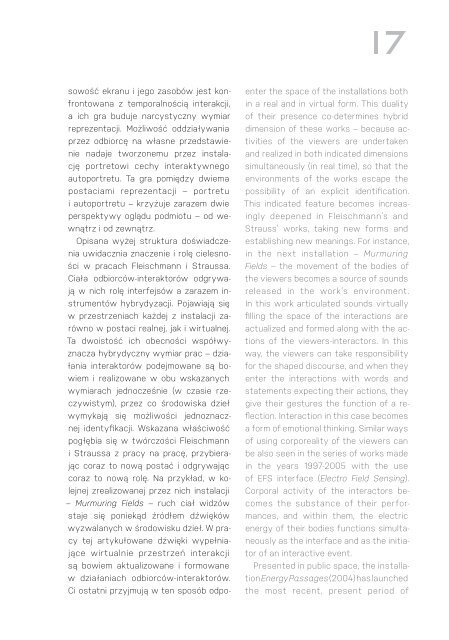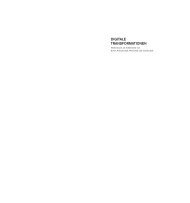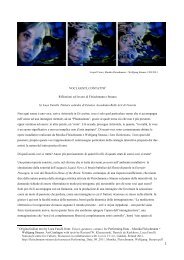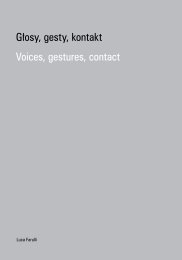Performing Data | Monika Fleischmann + Wolfgang Strauss
Performing Data is a review of Monika Fleischmann´s and Wolfgang Strauss´artistic body of work and a catalogue of their exhibition in Poland 2011. It presents works from Virtual Reality (Home of the Brain) up to Mixed Reality (Murmuring Fields) from Fluid Interface (Liquid Views) up to Floating Interface (Medienfluss) and texts by Ryszard W. Kluszczynski, Derrick de Kerkhove, Luca Farulli. Monika Fleischmann and Wolfgang Strauss from the German Fraunhofer research institute show us an intersection of the body and immaterial digital data. Immersion in data flow causes productive moments of disturbance and suspension, and consequently – a feeling of real physical presence. Fleischmann, Monika; Strauss, Wolfgang: Performing Data | Performowanie danych. National Centre for Culture, Warszawa 2011 in collaboration with Laznia CCArt, Gdańsk, Poland 2011 ISBN 978-83-61587-55-2 (en/pl) http://artline-southbaltic.eu/de/event/performing-data/
Performing Data is a review of Monika Fleischmann´s and Wolfgang Strauss´artistic body of work and a catalogue of their exhibition in Poland 2011. It presents works from Virtual Reality (Home of the Brain) up to Mixed Reality (Murmuring Fields) from Fluid Interface (Liquid Views) up to Floating Interface (Medienfluss) and texts by Ryszard W. Kluszczynski, Derrick de Kerkhove, Luca Farulli.
Monika Fleischmann and Wolfgang Strauss from the German Fraunhofer research institute show us an intersection of the body and immaterial digital data. Immersion in data flow causes productive moments of disturbance and suspension, and consequently – a feeling of real physical presence.
Fleischmann, Monika; Strauss, Wolfgang: Performing Data | Performowanie danych. National Centre for Culture, Warszawa 2011 in collaboration with Laznia CCArt, Gdańsk, Poland 2011 ISBN 978-83-61587-55-2 (en/pl) http://artline-southbaltic.eu/de/event/performing-data/
Create successful ePaper yourself
Turn your PDF publications into a flip-book with our unique Google optimized e-Paper software.
sowość ekranu i jego zasobów jest konfrontowana<br />
z temporalnością interakcji,<br />
a ich gra buduje narcystyczny wymiar<br />
reprezentacji. Możliwość oddziaływania<br />
przez odbiorcę na własne przedstawienie<br />
nadaje tworzonemu przez instalację<br />
portretowi cechy interaktywnego<br />
autoportretu. Ta gra pomiędzy dwiema<br />
postaciami reprezentacji – portretu<br />
i autoportretu – krzyżuje zarazem dwie<br />
perspektywy oglądu podmiotu – od wewnątrz<br />
i od zewnątrz.<br />
Opisana wyżej struktura doświadczenia<br />
uwidacznia znaczenie i rolę cielesności<br />
w pracach <strong>Fleischmann</strong> i <strong>Strauss</strong>a.<br />
Ciała odbiorców-interaktorów odgrywają<br />
w nich rolę interfejsów a zarazem instrumentów<br />
hybrydyzacji. Pojawiają się<br />
w przestrzeniach każdej z instalacji zarówno<br />
w postaci realnej, jak i wirtualnej.<br />
Ta dwoistość ich obecności współwyznacza<br />
hybrydyczny wymiar prac – działania<br />
interaktorów podejmowane są bowiem<br />
i realizowane w obu wskazanych<br />
wymiarach jednocześnie (w czasie rzeczywistym),<br />
przez co środowiska dzieł<br />
wymykają się możliwości jednoznacznej<br />
identyfikacji. Wskazana właściwość<br />
pogłębia się w twórczości <strong>Fleischmann</strong><br />
i <strong>Strauss</strong>a z pracy na pracę, przybierając<br />
coraz to nową postać i odgrywając<br />
coraz to nową rolę. Na przykład, w kolejnej<br />
zrealizowanej przez nich instalacji<br />
– Murmuring Fields – ruch ciał widzów<br />
staje się poniekąd źródłem dźwięków<br />
wyzwalanych w środowisku dzieł. W pracy<br />
tej artykułowane dźwięki wypełniające<br />
wirtualnie przestrzeń interakcji<br />
są bowiem aktualizowane i formowane<br />
w działaniach odbiorców-interaktorów.<br />
Ci ostatni przyjmują w ten sposób odpo-<br />
enter the space of the installations both<br />
in a real and in virtual form. This duality<br />
of their presence co-determines hybrid<br />
dimension of these works – because activities<br />
of the viewers are undertaken<br />
and realized in both indicated dimensions<br />
simultaneously (in real time), so that the<br />
environments of the works escape the<br />
possibility of an explicit identification.<br />
This indicated feature becomes increasingly<br />
deepened in <strong>Fleischmann</strong>’s and<br />
<strong>Strauss</strong>’ works, taking new forms and<br />
establishing new meanings. For instance,<br />
in the next installation – Murmuring<br />
Fields – the movement of the bodies of<br />
the viewers becomes a source of sounds<br />
released in the work’s environment.<br />
In this work articulated sounds virtually<br />
filling the space of the interactions are<br />
actualized and formed along with the actions<br />
of the viewers-interactors. In this<br />
way, the viewers can take responsibility<br />
for the shaped discourse, and when they<br />
enter the interactions with words and<br />
statements expecting their actions, they<br />
give their gestures the function of a reflection.<br />
Interaction in this case becomes<br />
a form of emotional thinking. Similar ways<br />
of using corporeality of the viewers can<br />
be also seen in the series of works made<br />
in the years 1997-2005 with the use<br />
of EFS interface (Electro Field Sensing).<br />
Corporal activity of the interactors becomes<br />
the substance of their performances,<br />
and within them, the electric<br />
energy of their bodies functions simultaneously<br />
as the interface and as the initiator<br />
of an interactive event.<br />
Presented in public space, the installation<br />
Energy Passages (2004) has launched<br />
the most recent, present period of







